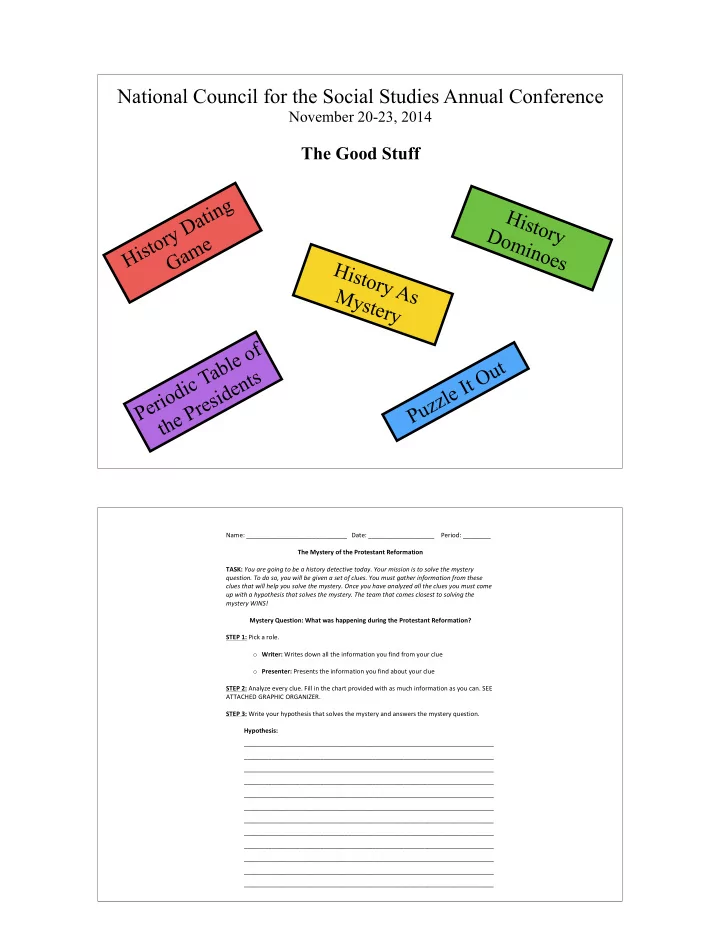

National Council for the Social Studies Annual Conference November 20-23, 2014 � The Good Stuff History Dating H i s t o r D y o Game m i n o e s History As Mystery Periodic Table of Puzzle It Out the Presidents Name:&_____________________________& Date:&___________________& Period:&________& & The$Mystery$of$the$Protestant$Reformation$ & TASK: !You!are!going!to!be!a!history!detective!today.!Your!mission!is!to!solve!the!mystery! question.!To!do!so,!you!will!be!given!a!set!of!clues.!You!must!gather!information!from!these! clues!that!will!help!you!solve!the!mystery.!Once!you!have!analyzed!all!the!clues!you!must!come! up!with!a!hypothesis!that!solves!the!mystery.!The!team!that!comes!closest!to!solving!the! mystery!WINS!!! ! Mystery$Question:$What$was$happening$during$the$Protestant$Reformation?$ & STEP$1: &Pick&a&role.&& & o Writer: &Writes&down&all&the&information&you&find&from&your&clue& & o Presenter: &Presents&the&information&you&find&about&your&clue& & STEP$2: &Analyze&every&clue.&Fill&in&the&chart&provided&with&as&much&information&as&you&can.&SEE& ATTACHED&GRAPHIC&ORGANIZER.& & STEP$3: &Write&your&hypothesis&that&solves&the&mystery&and&answers&the&mystery&question.& & Hypothesis: & ________________________________________________________________________ ________________________________________________________________________ ________________________________________________________________________ ________________________________________________________________________ ________________________________________________________________________ ________________________________________________________________________ ________________________________________________________________________ ________________________________________________________________________ ________________________________________________________________________ ________________________________________________________________________ ________________________________________________________________________ ________________________________________________________________________&
& CLUE$#$1:$(TITLE)$ Key$People$ Ideas$$ (Name&&&Information&you&learn&about&them)& (What&people&may&have&been&thinking)& & & Dates$$ Objects$ (When&and&what&happened)& &(What&they&are&and&what&they&might&be&used&for)& & Vocabulary/Terms$$ Other$$ (Words&that&seem&important&to&know&and&what&they& (Any&information&that&doesn’t&fit&in&the&other& mean)& categories)& & & CLUE$#$2:$(TITLE)$ Key$People$ Ideas$$ (Name&&&Information&you&learn&about&them)& (What&people&may&have&been&thinking)& & & Dates$$ Objects$ (When&and&what&happened)& &(What&they&are&and&what&they&might&be&used&for)& & Vocabulary/Terms$$ Other$$ (Words&that&seem&important&to&know&and&what&they& (Any&information&that&doesn’t&fit&in&the&other& mean)& categories)& & & CLUE$#$3:$(TITLE)$ Key$People$ Ideas$$ (Name&&&Information&you&learn&about&them)& (What&people&may&have&been&thinking)& & & Dates$$ Objects$ (When&and&what&happened)& &(What&they&are&and&what&they&might&be&used&for)& & Vocabulary/Terms$$ Other$$ (Words&that&seem&important&to&know&and&what&they& (Any&information&that&doesn’t&fit&in&the&other& mean)& categories)& & & CLUE$#$4:$(TITLE)$ Key$People$ Ideas$$ (Name&&&Information&you&learn&about&them)& (What&people&may&have&been&thinking)& & & Dates$$ Objects$ (When&and&what&happened)& &(What&they&are&and&what&they&might&be&used&for)& & Vocabulary/Terms$$ Other$$ (Words&that&seem&important&to&know&and&what&they& (Any&information&that&doesn’t&fit&in&the&other& mean)& categories)& &
& CLUE$#$5:$(TITLE)$ Key$People$ Ideas$$ (Name&&&Information&you&learn&about&them)& (What&people&may&have&been&thinking)& & & Dates$$ Objects$ (When&and&what&happened)& &(What&they&are&and&what&they&might&be&used&for)& & Vocabulary/Terms$$ Other$$ (Words&that&seem&important&to&know&and&what&they& (Any&information&that&doesn’t&fit&in&the&other& mean)& categories)& & & CLUE$#$6:$(TITLE)$ Key$People$ Ideas$$ (Name&&&Information&you&learn&about&them)& (What&people&may&have&been&thinking)& & & Dates$$ Objects$ (When&and&what&happened)& &(What&they&are&and&what&they&might&be&used&for)& & Vocabulary/Terms$$ Other$$ (Words&that&seem&important&to&know&and&what&they& (Any&information&that&doesn’t&fit&in&the&other& mean)& categories)& & CLUE ¡#1: ¡Religions ¡in ¡Europe ¡1100-‑1648 European ¡Religions ¡1100-‑1200
European ¡Religions ¡1560 European ¡Religions ¡1648
CLUE ¡#2: ¡Erasmus, ¡The ¡Praise ¡of ¡Folly The Praise of Folly is one of the most famous pieces of literature of the sixteenth century. Both contemporaries and later generations have appreciated "this laughing parody of every form and rank of human life." In this selection, Erasmus belittles one of his favorite objects of scorn-the monks. � “Those who are the closest to these [the theologians] in happiness are generally called "the religious" or "monks," both of which are deceiving names, since for the most part they stay as far away from religion as possible and frequent every sort of place. I cannot, however, see how ally life could be more gloomy than the life of these monks if I did not assist them in many ways. Though most people detest these men so much that accidentally meeting one is considered to be bad luck, the monks themselves believe that they are magnificent creatures. One of their chief beliefs is that to be illiterate is to be of a high state of sanctity, and so they make sure that they are not able to read. Another is that when braying out their gospels in church they are making themselves very pleasing and satisfying to God, when in fact they are uttering these psalms as a matter of repetition rather than from their hearts…they think that they are superior to all other people.” CLUE ¡#3: ¡The ¡Buying ¡of ¡Indulgences coffer Translation ¡of ¡text ¡on ¡the ¡left: ¡ � “By ¡buying ¡this ¡indulgence ¡ you ¡are ¡now ¡free ¡of ¡all ¡of ¡ your ¡sins ¡and ¡can ¡go ¡directly ¡ to ¡heaven.” ¡
CLUE ¡#4: ¡Martin ¡Luther ¡and ¡the ¡95 ¡Theses CLUE ¡#5:
CLUE ¡#6: Woodcuts ¡created ¡by ¡Martin ¡Luther ¡ and ¡spread ¡by ¡the ¡printing ¡press History Dating Game A matching activity with a twist: � students are given cards with names, dates, events, definitions, etc. � students are instructed to find another student to “date” - that they would have some sort of connection with � each pair will discuss what their connection is and share it with the class ( add one group of three if odd # of students ) � Extensions: � have students line up in a certain order ( chronological, cause and effect, etc. ) � students are now matched with another student for a subsequent activity ( rather than counting off ) � have the students create the cards as homework or a pairs activity
Recommend
More recommend